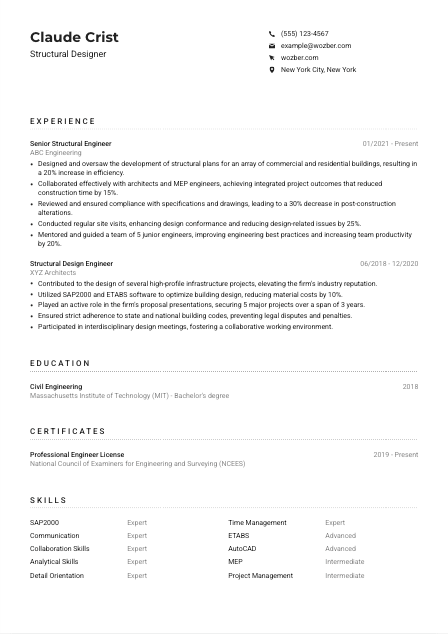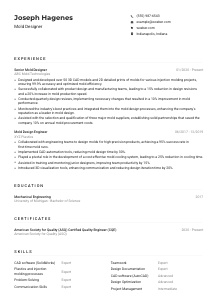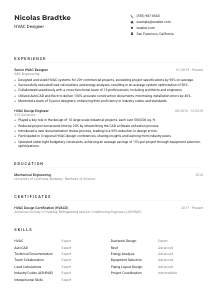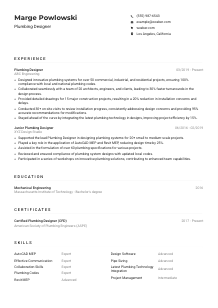Structural Designer Resume Example
Drafting blueprints, but your resume feels sketchy? Delve into this Structural Designer resume example, enhanced with Wozber free resume builder. It illustrates how you can fortify your design prowess to align with job frameworks, ensuring your career blueprint is solid as steel!

How to write a Structural Designer Resume?
Embarking on the exciting journey to land your dream Structural Designer role? Your resume isn't just a document; it's the blueprint of your career. Drawing on the power of Wozber's free resume builder, we're diving into the art of creating a resume that's not only robust but resonates with the essence of Structural Design. Our goal?
To ensure your resume, optimized with an ATS-friendly resume template, mirrors the precision and balance of a well-engineered structure. Ready to lay the foundation for your success? Let's design a resume that elevates your career to the next level.
Personal Details
Crafting the initial sketch of your resume begins with the Personal Details section – your chance to make a striking first impression. Let's perfect this blueprint to ensure it aligns impeccably with the Structural Designer position.
1. Pencil in Your Name
Your name is the keystone of your resume. Make it prominent, clear, and professional, using a font that's legible yet distinctive. This is not just a detail; it's the title of your career narrative.
2. Frame Your Title
Beneath your name, position the job title you're targeting - "Structural Designer." It immediately aligns your identity with the role, cueing the hiring manager to your career focus.
3. Ensure Contact Clarity
Your phone number and email are your contact beams. Use a current, professional email address that incorporates your name. Double-check for accuracy; even a single typo can derail your chances.
4. Mark Your Territory
Location is more than a simple detail; it's about logistics. Mentioning "New York City, New York" directly matches the job's geographical requirement, reassuring the employer of your availability.
5. Link to Your Professional Portfolio
If relevant, include a link to your LinkedIn profile or online portfolio. Ensure it's a mirror image of your resume, presenting a cohesive and detailed view of your professional landscape.
Takeaway
Like the foundation of any sturdy structure, your Personal Details must be solid, precise, and tailored. This is the beacon that guides the recruiter through the rest of your professional edifice. With these elements carefully laid out, you're ready to build upwards, adding layers of experience and skill that make your resume not just seen, but remembered.





Experience
The strength of your resume, much like any resilient structure, lies in its Experience section. Here, showcase your engineering feats, constructing a narrative that not only aligns with the Structural Designer role but underscores your expertise and successes.
- Designed and oversaw the development of structural plans for an array of commercial and residential buildings, resulting in a 20% increase in efficiency.
- Collaborated effectively with architects and MEP engineers, achieving integrated project outcomes that reduced construction time by 15%.
- Reviewed and ensured compliance with specifications and drawings, leading to a 30% decrease in post‑construction alterations.
- Conducted regular site visits, enhancing design conformance and reducing design‑related issues by 25%.
- Mentored and guided a team of 5 junior engineers, improving engineering best practices and increasing team productivity by 20%.
- Contributed to the design of several high‑profile infrastructure projects, elevating the firm's industry reputation.
- Utilized SAP2000 and ETABS software to optimize building design, reducing material costs by 10%.
- Played an active role in the firm's proposal presentations, securing 5 major projects over a span of 3 years.
- Ensured strict adherence to state and national building codes, preventing legal disputes and penalties.
- Participated in interdisciplinary design meetings, fostering a collaborative working environment.
1. Survey the Terrain
Begin with an examination of the job description. Identify the core responsibilities and required software proficiencies, such as experience with SAP2000 or ETABS, and previous collaboration in multidisciplinary teams. This understanding shapes the architecture of your experience section.
2. Lay the Foundation
Structure your experiences chronologically, starting with your most recent position. Clearly outline your title, the company's name, and the duration of your tenure, providing a clear scaffold of your career progression.
3. Construct Your Achievements
For each role, articulate your achievements with precision. Use action verbs to convey your impact on projects and how you excelled in collaboration, efficiency improvements, and adherence to building codes, directly reflecting the job requirements.
4. Fortify with Numbers
Quantifying your accomplishments lenses credibility and scale to your impact. Whether it's the percentage decrease in project timelines or the number of junior staff mentored, numbers reinforce the structural integrity of your experience section.
5. Prioritize Relevance
Every detail counts, but not every detail fits. Concentrate on experience that corresponds directly to the Structural Designer's role. Irrelevant roles can cloud your resume, obscuring the strength of your relevant experiences.
Takeaway
Your experience is the core of your career edifice; it's where you've proven your skills and made tangible impacts. Like reinforcing a structure for stability and endurance, spotlighting relevant, quantified achievements communicates your value with clarity and precision. Tailor this section meticulously, ensuring it reflects the requirements and responsibilities of a Structural Designer, and watch as your professional narrative takes shape, robust and compelling.
Education
In the realm of Structural Design, your educational background serves as the backbone. It fortifies your resume, providing indisputable proof of your technical foundation and readiness for the role.
1. Identify Educational Pillars
First, pinpoint the degree requirement from the job posting – in this case, a Bachelor's degree in Civil or Structural Engineering. This acknowledgment anchors your education section in the role's requirements.
2. Draft the Structure
Maintain clarity in this section, listing your degree, the institution, and your graduation year. A concise, transparent format ensures ease of validation and reflects your organizational skills.
3. Detail Your Curriculum
Align your degree and coursework with the job description. For example, highlighting courses in structural analysis, materials engineering, or design software proficiency like SAP2000 and ETABS showcases your preparedness for the role's technical demands.
4. Accentuate Relevant Extracurriculars
Supplement your education with pertinent clubs, projects, or thesis work that echoes the role's requirements or showcases your leadership qualities. This adds depth to your qualifications, portraying you as a well-rounded candidate.
5. Validate With Honors
If you have graduated with honors or received scholarships, mention these achievements. They act as testimonials to your dedication and expertise, further elevating your candidacy.
Takeaway
Your education is more than a list of qualifications; it's a narrative of your dedication and a testament to your foundational knowledge in Structural Design. Craft this section to resonate with the employer's needs, exhibiting not just your eligibility, but your distinction. Armed with a well-constructed Education section, your resume stands as a more compelling contender in the competitive landscape.
Certificates
Bolstering your resume with certifications can be the reinforcement that distinguishes you from other candidates. It evidentially showcases your commitment to ongoing education and professional excellence in the Structural Design field.
1. Asses Job Blueprint
Commence by revisiting the job posting to discern if specific certifications are encouraged. While our Structural Designer role may not explicitly demand them, certifications like a Professional Engineer License directly contribute to your appeal.
2. Select Strategically
Prioritize listing certifications that best align with the role's competencies and the industry's advances. Having up-to-date certifications signals your dedication to staying at the forefront of Structural Design practices.
3. Date Your Achievements
Include the acquisition or renewal dates for your certifications. This detail is crucial, offering insight into the currency of your expertise and your commitment to professional development.
4. Refresh and Renew
The field of Structural Design is perpetually evolving, emphasizing the importance of continuous learning. Stay informed about emerging technologies and methodologies, ensuring your certifications remain relevant and reflective of industry standards.
Takeaway
Certifications are the special features that enhance the structural integrity of your resume. They are concrete evidence of your skills, learning agility, and professional growth. Curating this section with relevant and current certifications fortifies your candidacy, demonstrating your commitment to excellence in Structural Design.
Skills
The Skills section is akin to the load-bearing walls of your resume - crucial and foundational. Let's engineer this section to display your proficiency in both the technical tools of the trade and the soft skills that facilitate collaborative success.
1. Blueprint Your Talents
Start by delineating the skills that are explicitly required for the Structural Designer role, such as proficiency in SAP2000 and ETABS, and understanding of building codes and regulations.
2. Highlight Structural Competencies
Include a mix of technical skills and software proficiencies directly related to the job, alongside essential soft skills like communication, collaboration, and analytical thinking, painting a complete picture of your capabilities.
3. Organize for Impact
Avoid overwhelming the section with an exhaustive list. Instead, prioritize and categorize your skills into technical and soft skills, making it easy for hiring managers to assess your fit for the role quickly.
Takeaway
In the architectural masterpiece that is your resume, the Skills section needs to firmly support your candidacy. Curate it to showcase your technical prowess and your ability to mesh within multidisciplinary teams seamlessly. Remember, it's not just about the tools you can use; it's also about how you use them to achieve collaborative and efficient project outcomes. Presenting a well-rounded skillset is your ticket to proving you're not just a fit, but a standout candidate for the Structural Designer role.
Languages
Communicating effectively in New York's melting pot can be as crucial as the structural integrity of a skyscraper. Your ability to speak multiple languages can significantly augment your professional repertoire, potentially opening doors to global projects.
1. Interpret Job Linguistics
Assess if the role prioritizes specific language skills. For instance, our Structural Designer must operate effectively in English, making it imperative to highlight proficiency in this language.
2. Elevate Required Languages
Position your mastery of the English language prominently, characterizing your proficiency level accurately to align with the job requirement.
3. Showcase Additional Linguistic Frameworks
Even if not explicitly required, additional languages can enrich your resume, demonstrating your capability to navigate multicultural environments and collaborate on international projects.
4. Be Transparent in Proficiency
Clarity in your language proficiency levels - whether Native, Fluent, Intermediate, or Basic - provides a realistic understanding of your communication skills, ensuring expectations are appropriately set.
5. Gauge the Global Span
In roles that might engage with diverse populations or international projects, fluency in multiple languages can be a significant advantage, setting you apart as a globally-minded professional.
Takeaway
Languages are the mortar holding together the diverse blocks of a global professional network. Flaunting your multilingual abilities enriches your resume, providing a competitive edge in a multicultural job market. As a Structural Designer in a cosmopolitan city like New York, this ability underscores your adaptability and readiness to thrive in varied communication landscapes. Let your linguistic skills bridge the gap to new opportunities, enhancing your professional framework.
Summary
The Summary stakes the groundwork, setting the tone for the narrative of your Structural Designer career. A well-constructed summary not only captures attention but also encapsulates your value proposition succinctly.
1. Draft Your Blueprint
Start with a clear understanding of the role's requirements. This insight will guide you in weaving a compelling intro that spotlights your career and experience in the field of Structural Design.
2. Cement Your Introduction
Begin with a strong statement that underlines your profession and years of experience. Immediately aligning yourself with the Structural Designer role sets a focused trajectory for the reader.
3. Reinforce with Core Competencies
Highlight key skills and achievements that resonate with the job description, such as your expertise in using specific design software or leading multidisciplinary project teams. This alignment with the role's demands underlines your candidacy's strength.
4. Keep It Structurally Sound
Aim for brevity while ensuring your summary is impactful. 3-5 lines are sufficient to deliver a powerful, concentrated overview of your professional persona, leaving the hiring manager eager to learn more.
Takeaway
Your summary is the keystone, elegantly arching over the comprehensive details of your resume, inviting the hiring manager into your career narrative. Tailoring this section with a concise yet impactful overview primes your resume for success, setting a strong, professional tone. Invigorate your summary with the essence of your achievements and skills, and watch as it paves the way to landing your desired Structural Designer role. Remember, in the blueprint of your career, every word counts, shaping the path to new opportunities.
Launching Your Structural Designer Journey
Congratulations! You're now equipped with a robust template and invaluable insights into sculpting a resume that not only fulfills but surpasses the expectations for a Structural Designer role. Remember, your resume is a dynamic blueprint of your professional journey, designed to evolve and adapt. Utilizing Wozber's free resume builder, with access to ATS-friendly resume templates and a dedicated ATS resume scanner, ensures your resume not only aligns with industry standards but excels at every level.
Embrace this opportunity to redefine your professional narrative, leveraging every tool at your disposal to construct a resume that opens doors. Your next great project awaits. Let your revamped resume be the cornerstone of your career advancement.

- Bachelor's degree in Civil or Structural Engineering.
- Minimum of 5 years of experience in structural design, preferably in the building or construction industry.
- Proficiency in using structural design software such as SAP2000 or ETABS.
- Strong understanding of local and national building codes and regulations.
- Excellent communication and collaboration skills for working in multidisciplinary teams.
- Must be able to operate effectively in English.
- Must be located in New York City, New York.
- Design and oversee the development of structural plans, specifications, and calculations for various types of buildings and infrastructure projects.
- Collaborate closely with architects, MEP engineers, and other design professionals to ensure integrated and efficient project outcomes.
- Review and interpret project contracts, drawings, and specifications.
- Conduct site visits and inspections to ensure design conformance and quality assurance.
- Mentor and provide guidance to junior design staff on engineering best practices.















